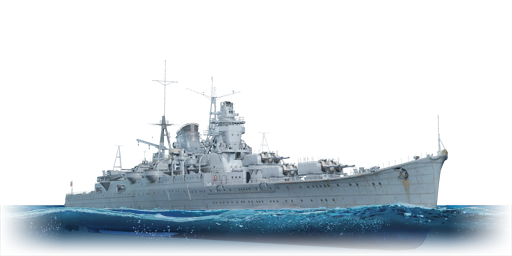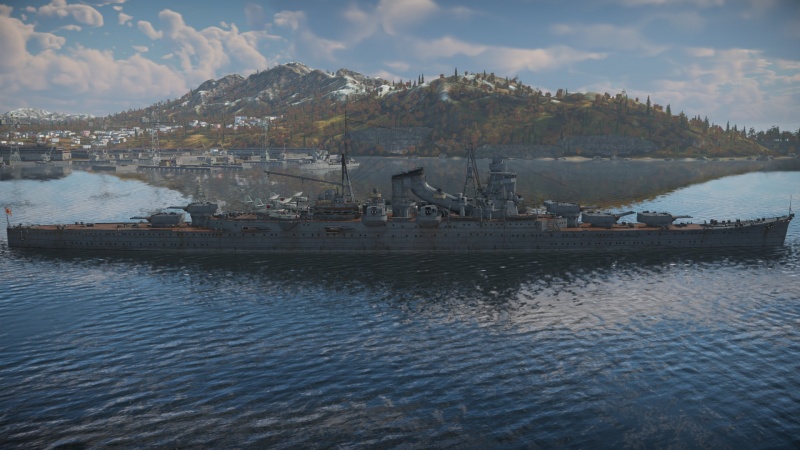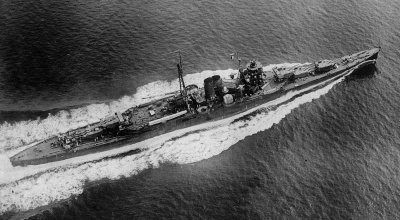IJN Suzuya
| This page is about the Japanese light cruiser IJN Suzuya. For other uses, see Mogami (Family). |
Contents
Description
The Mogami-class, IJN Suzuya, 1937 is a rank V Japanese light cruiser with a battle rating of 6.0 (AB/RB/SB). It was introduced in Update 1.95 "Northern Wind".
General info
Survivability and armour
Talk about the vehicle's armour. Note the most well-defended and most vulnerable zones, e.g. the ammo magazine. Evaluate the composition of components and assemblies responsible for movement and manoeuvrability. Evaluate the survivability of the primary and secondary armaments separately. Don't forget to mention the size of the crew, which plays an important role in fleet mechanics. Save tips on preserving survivability for the "Usage in battles" section. If necessary, use a graphical template to show the most well-protected or most vulnerable points in the armour.
Mobility
Write about the ship's mobility. Evaluate its power and manoeuvrability, rudder rerouting speed, stopping speed at full tilt, with its maximum forward and reverse speed.
| Mobility Characteristics | |||
|---|---|---|---|
| Game Mode | Upgrade Status | Maximum Speed (km/h) | |
| Forward | Reverse | ||
| AB | |||
| Upgraded | 78 | 25 | |
| RB/SB | |||
| Upgraded | 67 | 22 | |
Modifications and economy
Armament
Primary armament
Provide information about the characteristics of the primary armament. Evaluate their efficacy in battle based on their reload speed, ballistics and the capacity of their shells. Add a link to the main article about the weapon: {{main|Weapon name (calibre)}}. Broadly describe the ammunition available for the primary armament, and provide recommendations on how to use it and which ammunition to choose.
Secondary armament
Some ships are fitted with weapons of various calibres. Secondary armaments are defined as weapons chosen with the control Select secondary weapon. Evaluate the secondary armaments and give advice on how to use them. Describe the ammunition available for the secondary armament. Provide recommendations on how to use them and which ammunition to choose. Remember that any anti-air armament, even heavy calibre weapons, belong in the next section. If there is no secondary armament, remove this section.
Anti-aircraft armament
An important part of the ship's armament responsible for air defence. Anti-aircraft armament is defined by the weapon chosen with the control Select anti-aircraft weapons. Talk about the ship's anti-air cannons and machine guns, the number of guns and their positions, their effective range, and about their overall effectiveness – including against surface targets. If there are no anti-aircraft armaments, remove this section.
Additional armament
Describe the available additional armaments of the ship: depth charges, mines, torpedoes. Talk about their positions, available ammunition and launch features such as dead zones of torpedoes. If there is no additional armament, remove this section.
Scout plane
Located amidships are two catapults each carrying one E8N2 scout plane (the third E8N2 and single E7K2 stored on trolleys are not available) provide unique offensive and defensive abilities, expanding tactical options.
Usage in battles
Describe the technique of using this ship, the characteristics of her use in a team and tips on strategy. Abstain from writing an entire guide – don't try to provide a single point of view, but give the reader food for thought. Talk about the most dangerous opponents for this vehicle and provide recommendations on fighting them. If necessary, note the specifics of playing with this vehicle in various modes (AB, RB, SB).
Pros and cons
Pros:
- Features the same hull as the Mogami heavy cruiser; able to withstand a fair amount of enemy fire before sinking
- Lots of guns (5 turrets with 3 guns in each turret)
- 24 Long Lance torpedoes
- Anti-torpedo bulges along the hull are filled with water and can absorb explosions of up to 250 kg TNT equivalent
- Very fast for a cruiser of this size
- Two scout planes.
Cons:
- Like most Japanese cruisers, very weak anti-aircraft armament
- Wide hull makes evading enemy torpedoes difficult as it takes some time to manoeuvre the ship
- Torpedo arcs are limited, have to show almost full broadside to launch torpedoes. Better rear angles than forward.
- Slow rate of fire for the calibre of guns: guns have longer reload than equivalent guns in other nations
- Large, lightly armoured turrets can be easily knocked out
History
The IJN Suzuya was the third of four Mogami-class heavy cruisers built for the Imperial Japanese navy. To comply with the regulations of the Washington Naval Treaty, she was classified as a light cruiser and built with fifteen 6-inch (152 mm) guns. However, the ship was designed from the outset to be armed with dual 8-inch (203 mm) turrets, which were refitted onto the ship in 1937. Suzuya served extensively in the Second World War, participating in major conflicts such as the Battle of Midway, Solomon Islands campaign and the Battle of the Philippine Sea. Suzuya met her end at the Battle of Leyte Gulf, where she was crippled by American torpedo bombers and subsequently abandoned.
Design and construction
Suzuya was the third of four Mogami-class cruisers. To comply with the Washington Naval Treaty, she was initially classified as a light cruiser with an official displacement of 8,500 tons. However, she was designed from the outset to be refitted with 8-inch (203 mm) guns and made into a heavy cruiser in a later refit.[1] Her main armament consisted of fifteen 6-inch (152 mm) guns in five triple turrets, giving her one of the heaviest broadsides of any Treaty cruiser. She was also fitted with moderate anti-aircraft protection and four triple torpedo tube launchers carrying the deadly Type 93 "Long Lance" torpedoes.[1]
Suzuya was launched on November 20th 1934 at a ceremony attended by Emperor Hirohito. She was completed in January of 1936 but was immediately drydocked to allow her hull to be reinforced. She entered service in late 1937, but was immediately drydocked again to be refitted with her intended armament of ten 8-inch (203 mm) guns in five dual mounts.[1] In-game, Suzuya appears in her pre-modification light cruiser configuration.
Operational history
Following her rearmament, which was completed by December 30th 1939, Suzuya was assigned to the 7th Cruiser Division of the Japanese 2nd fleet, along with her sister ships Mogami, Mikuma and Kumano. Before the war, she served primarily in the South China Sea, as well as the occupation of French Indochina.[2] At the time of the Pearl Harbour attack, she was covering the invasion of Malaya; she was subsequently part of a task force hunting for the British Force Z (consisting of the battleship Prince of Wales, battlecruiser Repulse and escorting destroyers), but proved unsuccessful in locating her target; the ships were eventually sunk by Japanese torpedo bombers.[1][2]
From April 1st 1942, Suzuya participated in commerce raiding in the Indian ocean, intercepting and destroying several Allied merchantmen. She went on to serve at the Battle of Midway, where she intended to shell the island in preparation for the Japanese invasion; this order was called off.[2] She saw extensive service escorting the Japanese carrier fleet during the Solomon islands campaign, and participated in the bombing of Henderson Field at Guadalcanal. She was attacked by American torpedo-bombers, but survived unscathed.[2]
In mid-1944, Suzuya was part of the cruiser squadron escorting the Japanese carrier fleet on the Marianas campaign; however, American aircraft decimated the Japanese air group in the 'Great Marianas Turkey Shoot', resulting in the crippling of Japan's remaining carrier air group. She met her own demise just three months later, at the Battle of Leyte Gulf; attacked by American aircraft, a bomb near-miss caused her No. 1 torpedo tube, laden with Long Lance torpedoes, to explode.[2] The resulting fire caused severe damage, and she was abandoned. Suzuya was removed from the navy list in December of 1944. Her wreck has never been found, and is believed to lie at a depth of almost 9 kilometres.[1][2]
Media
Excellent additions to the article would be video guides, screenshots from the game, and photos.
See also
Links to articles on the War Thunder Wiki that you think will be useful for the reader, for example:
- reference to the series of the ship;
- links to approximate analogues of other nations and research trees.
External links
References
Works Cited
- Chen, C. (2007, October). Heavy Cruiser Suzuya. Retrieved November 19, 2020, from https://ww2db.com/ship_spec.php?ship_id=40
- Hackett, B., & Kingsepp, S. (2018). IJN SUZUYA: Tabular Record of Movement. Retrieved November 19, 2020, from http://www.combinedfleet.com/suzuya_t.htm
| Yokosuka Naval Arsenal (横須賀海軍工廠) | |
|---|---|
| Destroyers (DD) | |
| Momi-class | IJN Momi |
| Light Cruisers (CL) | |
| Mogami-class | IJN Suzuya |
| Heavy Cruisers (CA) | |
| Myōkō-class | IJN Myoko |
| Battlecruisers (BC) | |
| Kurama-class | IJN Kurama |
| Amagi-class | IJN Amagi |
| Battleships (BB) | |
| Fusō-class | IJN Yamashiro |
| Nagato-class | IJN Mutsu |
| Tanks | Ka-Mi · Ka-Chi · Chi-Ha LG |
| See also | Yokosuka Naval Air Technical Arsenal |
| Japan light cruisers | |
|---|---|
| Kuma-class | IJN Tama |
| IJN Yubari* | |
| Nagara-class | IJN Isuzu |
| Sendai-class | IJN Sendai |
| Agano-class | IJN Agano |
| Mogami-class | IJN Mikuma · IJN Suzuya |
| * Unique ship | |






